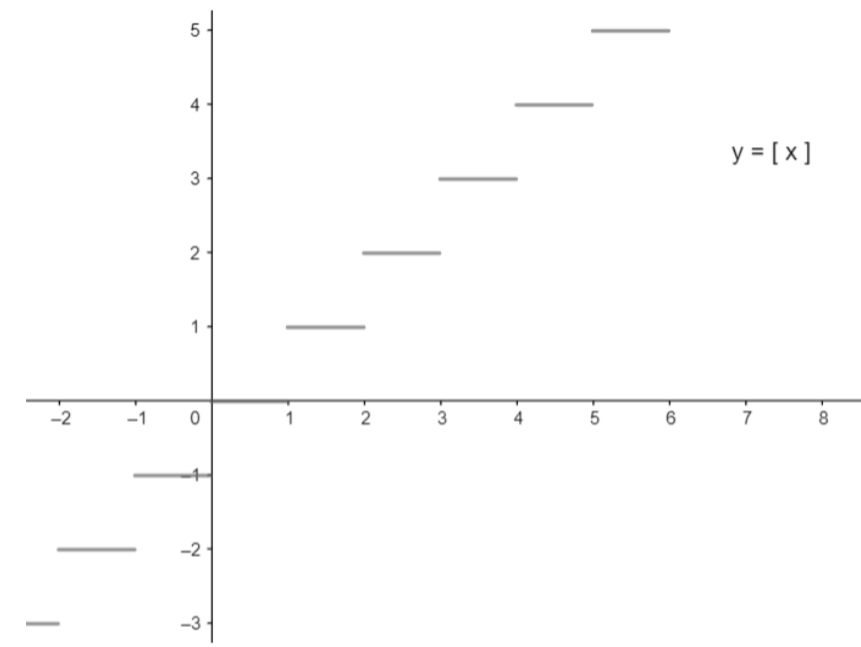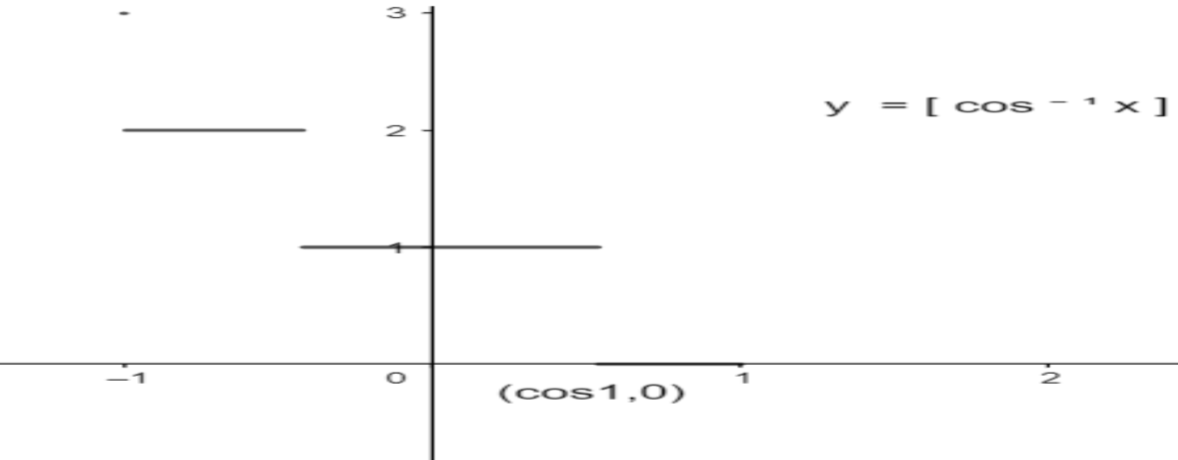
if we have a trigonometric expression as $[{{\cot }^{-1}}x]+[{{\cos }^{-1}}x]=0$ , where [ . ] denotes greatest integer function, then the complete set of values of x is
( a ) (cos1, 1]
( b ) ( cos1, - cos1)
( c ) (cot1, 1]
( d ) none of these
Answer
573.6k+ views
Hint: What we will do is we will first draw the graph of ${{\cos }^{-1}}x$ and ${{\cot }^{-1}}x$ using concept of greatest integer function. Then we will first see for what values of x, ${{\cos }^{-1}}x$ and ${{\cot }^{-1}}x$ is equals to zero. Then we will take intersection of set of domain of values of x for $[{{\cos }^{-1}}x]=0$ and $[{{\cot }^{-1}}x]=0$.
Complete step-by-step solution:
Before we start the question, let us see what is the greatest integer function and what are its properties.
Function y = [ x ] is called greatest integer function which means the greatest integer less than or equals to x. also, if n belongs to set of integer, then y = [ x ] = n if $n\le xFor example if we put x = -3.1 in y = [ x ], then y = - 4 and if we put x = 0.2 in y = [ x ], then y = 0.
Graph of y = [ x ] is given as,

Graph of $y=[{{\cot }^{-1}}x]$ is given as,

Graph of $y=[{{\cos }^{-1}}x]$ is given as

Now, in question it is given that $[{{\cot }^{-1}}x]+[{{\cos }^{-1}}x]=0$
Now, we know that range of ${{\cos }^{-1}}x$ is $0\le {{\cos }^{-1}}x\le \pi $.
So from seeing the range of ${{\cos }^{-1}}x$, we can say that ${{\cos }^{-1}}x$ is always positive for all values of x. where x belongs to a set of real numbers.
Also, we know that range of ${{\cot }^{-1}}x$ is $0<{{\cot }^{-1}}x\le \pi $.
So from seeing the range of ${{\cot }^{-1}}x$, we can say that ${{\cos }^{-1}}x$ is always positive for all values of x. where x belongs to a set of real numbers.
Now for, values of ${{\cot }^{-1}}x$ and ${{\cos }^{-1}}x$, $[{{\cot }^{-1}}x]+[{{\cos }^{-1}}x]=0$is true when both $[{{\cot }^{-1}}x]$ and $[{{\cos }^{-1}}x]$ are equals to zero.
Now, from graph of $[{{\cos }^{-1}}x]$, $[{{\cos }^{-1}}x]$ is always zero for values between cos1 and 1 that is,
$[{{\cos }^{-1}}x]=0;x\in (\cos 1,1]$….( i )
Now, from graph of $[{{\cot }^{-1}}x]$, $[{{\cot }^{-1}}x]$ is always zero for values between cot1 and $\infty $ that is,
$[{{\cot }^{-1}}x]=0;x\in (\cot 1,\infty )$……( ii )
Taking intersection of equation ( i ) and ( ii )
So, set of all values x for which $[{{\cot }^{-1}}x]+[{{\cos }^{-1}}x]=0$ is $x\in (\cot 1,1]$
Hence, option ( c ) is true.
Note: For finding domain of functions which are formed by combination of some function of x and greatest integer function, knowledge of graph is must. If we have $f(x)={{f}_{1}}(x)+{{f}_{2}}(x)$ , then domain of f(x) is equals to domain of ${{f}_{1}}(x)\cap {{f}_{2}}(x)$.
Complete step-by-step solution:
Before we start the question, let us see what is the greatest integer function and what are its properties.
Function y = [ x ] is called greatest integer function which means the greatest integer less than or equals to x. also, if n belongs to set of integer, then y = [ x ] = n if $n\le x
Graph of y = [ x ] is given as,

Graph of $y=[{{\cot }^{-1}}x]$ is given as,

Graph of $y=[{{\cos }^{-1}}x]$ is given as

Now, in question it is given that $[{{\cot }^{-1}}x]+[{{\cos }^{-1}}x]=0$
Now, we know that range of ${{\cos }^{-1}}x$ is $0\le {{\cos }^{-1}}x\le \pi $.
So from seeing the range of ${{\cos }^{-1}}x$, we can say that ${{\cos }^{-1}}x$ is always positive for all values of x. where x belongs to a set of real numbers.
Also, we know that range of ${{\cot }^{-1}}x$ is $0<{{\cot }^{-1}}x\le \pi $.
So from seeing the range of ${{\cot }^{-1}}x$, we can say that ${{\cos }^{-1}}x$ is always positive for all values of x. where x belongs to a set of real numbers.
Now for, values of ${{\cot }^{-1}}x$ and ${{\cos }^{-1}}x$, $[{{\cot }^{-1}}x]+[{{\cos }^{-1}}x]=0$is true when both $[{{\cot }^{-1}}x]$ and $[{{\cos }^{-1}}x]$ are equals to zero.
Now, from graph of $[{{\cos }^{-1}}x]$, $[{{\cos }^{-1}}x]$ is always zero for values between cos1 and 1 that is,
$[{{\cos }^{-1}}x]=0;x\in (\cos 1,1]$….( i )
Now, from graph of $[{{\cot }^{-1}}x]$, $[{{\cot }^{-1}}x]$ is always zero for values between cot1 and $\infty $ that is,
$[{{\cot }^{-1}}x]=0;x\in (\cot 1,\infty )$……( ii )
Taking intersection of equation ( i ) and ( ii )
So, set of all values x for which $[{{\cot }^{-1}}x]+[{{\cos }^{-1}}x]=0$ is $x\in (\cot 1,1]$
Hence, option ( c ) is true.
Note: For finding domain of functions which are formed by combination of some function of x and greatest integer function, knowledge of graph is must. If we have $f(x)={{f}_{1}}(x)+{{f}_{2}}(x)$ , then domain of f(x) is equals to domain of ${{f}_{1}}(x)\cap {{f}_{2}}(x)$.
Recently Updated Pages
A man running at a speed 5 ms is viewed in the side class 12 physics CBSE

The number of solutions in x in 02pi for which sqrt class 12 maths CBSE

State and explain Hardy Weinbergs Principle class 12 biology CBSE

Write any two methods of preparation of phenol Give class 12 chemistry CBSE

Which of the following statements is wrong a Amnion class 12 biology CBSE

Differentiate between action potential and resting class 12 biology CBSE

Trending doubts
What are the major means of transport Explain each class 12 social science CBSE

Which are the Top 10 Largest Countries of the World?

Draw a labelled sketch of the human eye class 12 physics CBSE

Explain sex determination in humans with line diag class 12 biology CBSE

Explain sex determination in humans with the help of class 12 biology CBSE

Differentiate between homogeneous and heterogeneous class 12 chemistry CBSE




